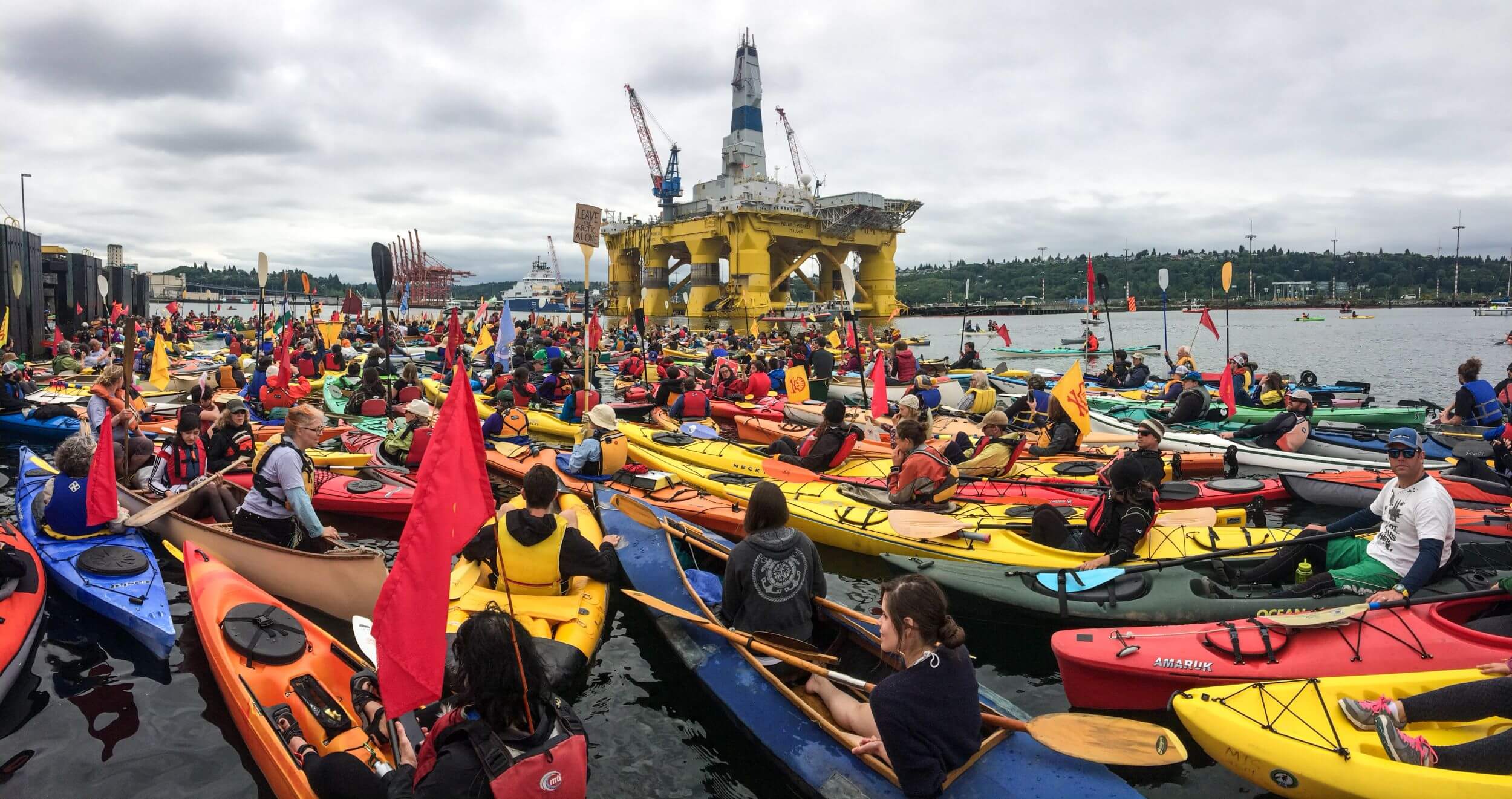During a decade when Cascadia’s governments flouted their carbon emissions goals, activists fighting fossil fuel exports exceeded their wildest expectations.
SEATTLE — At the corner of Third and Union, amid a sea of downtown high-rises and just across from Macy’s, members of the Northern Cheyenne tribe in native regalia walked alongside Montana ranchers in cowboy hats. The ranchers’ forerunners occupied the same stretch of the Little Bighorn River where Lakota, Northern Cheyenne and Arapaho warriors crushed the infamous U.S. Army General George Custer. On this December morning in 2012, however, they made common cause.
 First the Cheyenne and ranchers set out together to find breakfast. Then they walked to Seattle’s Convention Center to square off against a modern-day enemy with global reach: coal firms proposing to move mile-long-plus trains through the Pacific Northwest to be loaded on ships bound for Asia.
First the Cheyenne and ranchers set out together to find breakfast. Then they walked to Seattle’s Convention Center to square off against a modern-day enemy with global reach: coal firms proposing to move mile-long-plus trains through the Pacific Northwest to be loaded on ships bound for Asia.
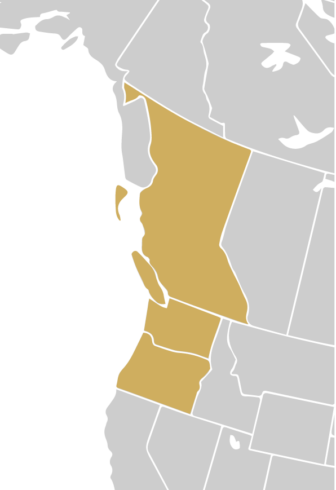
Their partnership went the distance. Three years after that hearing, the proposed Washington coal terminal was dead. Those trains bearing Montana and Wyoming coal never rolled.
Opponents’ victory in that case was emblematic of how environmentalists, Indian tribes, ranchers, politicians, doctors, fishermen and even windsurfers worked for a decade to fend off more than 20 proposals to ship fossil fuels across the Pacific, from near Prince Rupert, British Columbia, clear south to San Luis Obispo, California.
Government action to slash greenhouse gas emissions fell short in Washington, Oregon and British Columbia during the decade after they mandated their first targets — as documented last week in the opening story in InvestigateWest’s yearlong series, Getting to Zero: Decarbonizing Cascadia. But as policymakers in Cascadia fell short, its activists triumphed.
Against the odds, and even their own expectations, activists blocked nearly every effort to use the region’s ports to expand the global fossil fuel trade between 2004 and 2017, according to research by InvestigateWest. Their victorious streak continued this month when the Australian firm pushing for a major coal-export terminal in Longview, Washington, threw in the towel.
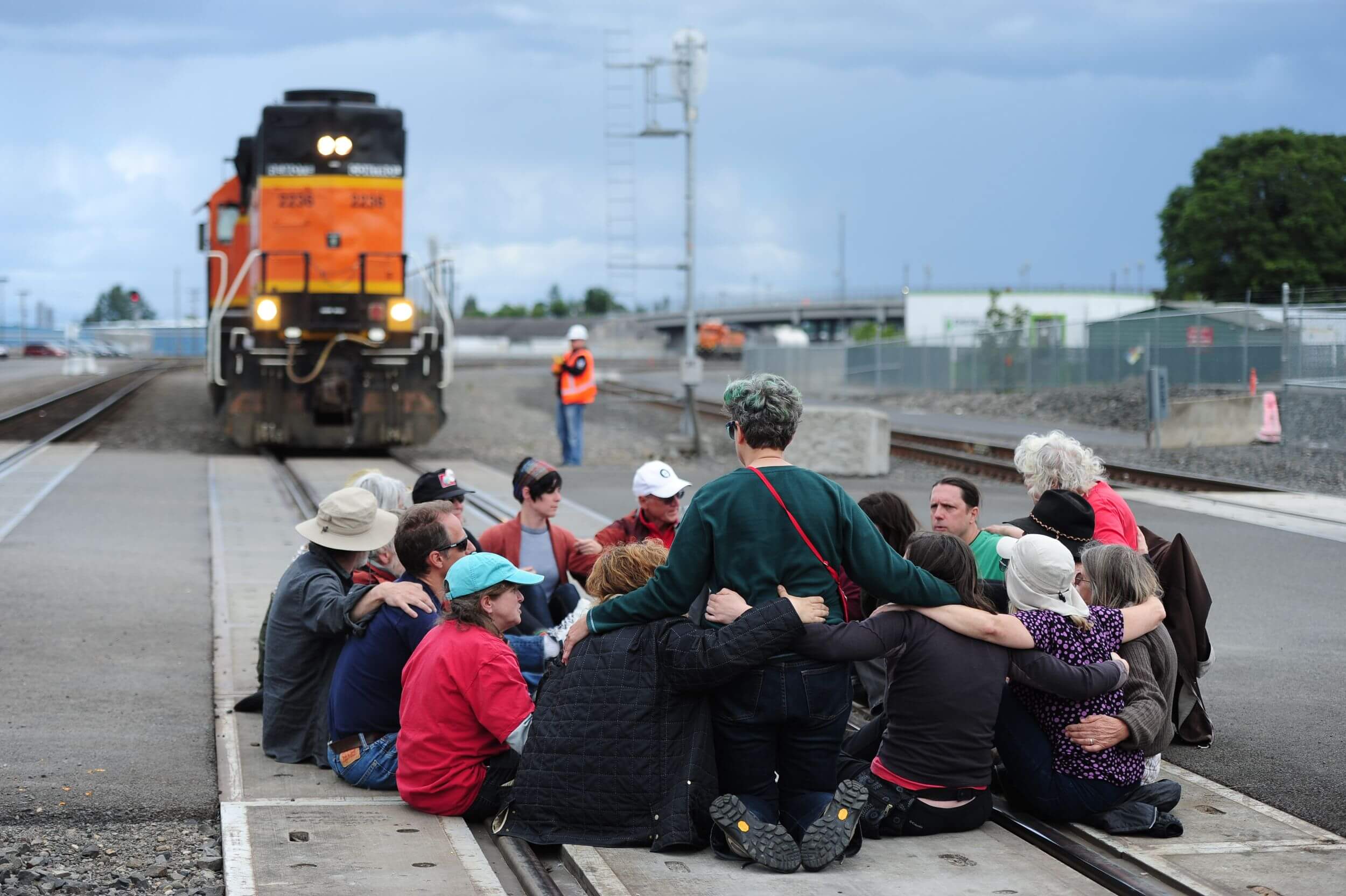
Cascadian activists have in some cases employed civil disobedience tactics in their fight to keep the region from becoming a major export center for planet-warming fossil fuels. Here, protesters block the main BNSF rail line in Vancouver, Washington, on June 18, 2016, as police begin to move in. The action was organized by the Fossil Fuel Resistance Network in response to a recent oil train derailment in Mosier, Oregon, to highlight the risks of fossil fuel transportation. (Photo by Alex Milan Tracy)
Industry wanted to turn the Pacific Northwest into a fossil fuel export hub. Instead, environmentalists assembled coalitions that shut down or brought to a near-standstill proposals that, taken together, would have punched the carbon equivalent of five Keystone XL pipelines through Cascadia and its ports, according to research by the Seattle-based think tank Sightline Institute. Just last week, the owners of a proposed coal-export terminal in Longview, Washington, known as the Millennium Bulk Terminal, pulled the plug on the project.
A few significant energy-export proposals have been revived under the Trump and Trudeau administrations. (More on that in next month’s installment of Getting To Zero: Decarbonizing Cascadia.)
Still, that wave of earlier victories represents the region’s greatest contribution to climate action, according to KC Golden, a longtime policy leader who spent over a decade at Climate Solutions, a regional group headquartered in Seattle at the center of the opposition.
“You can’t measure that on our emissions curve, but it’s probably the single biggest thing that we did,” said Golden, who now serves on the board of the international climate-action group 350.org.
How did they do it?
Green groups saw success in fighting fuel-export proposals along the Pacific coast because they successfully enlisted non-traditional allies. And also because they put a lot of calories into figuring out how coal and oil were set to be physically exported. And then enlisting those communities at risk.
They targeted the underground pipelines snaking beneath communities. And the mile-long-plus trains rumbling through downtowns, cutting off emergency service vehicles and all other traffic numerous times daily. And the fuel processing plants that spew pollution into the air of often marginalized communities — all en route to impacting a warming planet.
Regional factors also played a role. Native American tribes and First Nations bands invoked their sovereign powers to muscle political power. And Cascadia’s liberal leanings and economic makeup eased the lift politically. Fossil fuel production makes up a small part of the region’s job base, and many politicians score with voters by opposing the likes of Big Oil. (Then-Seattle City Council member Mike O’Brien, once dubbed the city’s Most Divisive Man, had nothing to lose when he paddled into Seattle’s Elliott Bay to block a Shell drilling platform bound for the Arctic. O’Brien numbered among dozens of “kayaktivists” arrested that June, three months before the oil major shelved its Arctic drilling plans.)
The most important factor, though, was the sheer number of people that activists mobilized by reaching beyond their traditional alliances. In massive numbers, community members attended public hearings. Marched in protests. Spent nights and weekends at kitchen tables drafting pleas to government agencies.
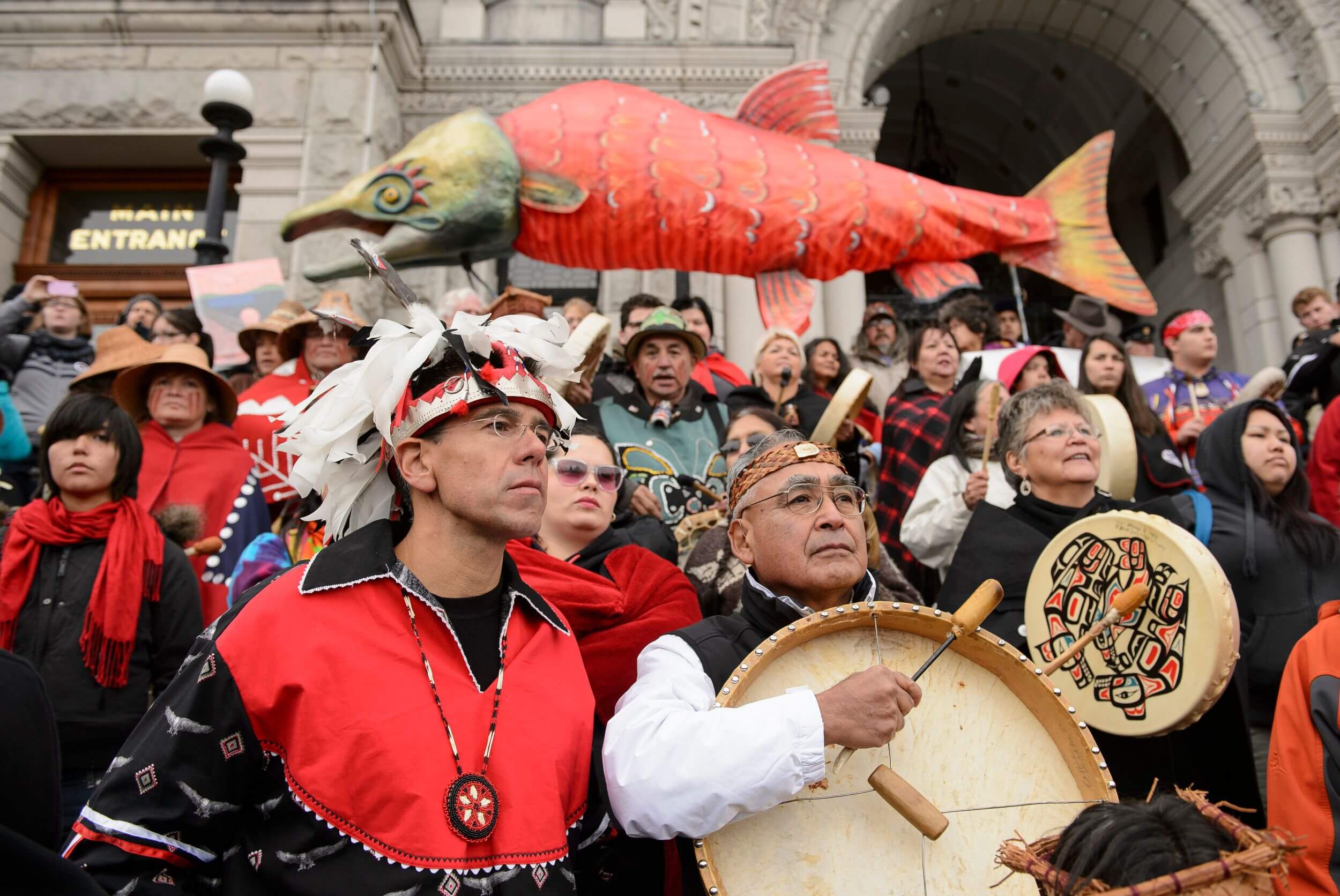
Protesters amass outside the British Columbia legislative building in Victoria Oct. 22, 2012, opposing the XL-Northern Gateway pipeline to bring oil from the Alberta tarsands. The project was rejected by a federal appeals court in 2016. However, another similar project is currently being built. (Christopher Morris/Corbis, Getty Images)
“Clearly part of what is different about this campaign is the fairly extraordinary level of grassroots involvement,” said Becky Kelley, former president of the Washington Environmental Council.
This story of uncharacteristic environmental victories has its roots in the mid-2000s, when growing use of so-called “natural” gas produced several proposals to import liquefied [su_tooltip position=”north” shadow=”yes” size=”2″ title=”Natural gas” content=”A gaseous fossil fuel primarily composed of methane. Supply expanded in the U.S. and Canada with the introduction of hydraulic fracturing or ‘fracking’, a production method that shatters underground rock formations to release gas trapped within pores in the rock. Natural gas served as a ‘bridge fuel’ by serving as a substitute to dirtier coal-fired power plants. But with climate goals tightening the pressure is on to replace natural gas with renewable energy.”][su_highlight background=”#ffeb1c”]natural gas[/su_highlight][/su_tooltip] to ports in Oregon. That would require pipelines to move the fossil gas east, taking peoples’ land. Lots of land, as it turned out, and much of it in solidly conservative expanses of the state.
Fracking turned that picture upside down. Cheaper domestic gas spurred three new waves of export proposals: Facilities to take coal transported by rail; oil transported by rail and pipeline; and then — once again — gas from pipelines. This time the latter would carry gas westward for export.
If all the proposals for coal exports went through, it would mean 50 to 60 trains per day traveling through the region, according to calculations by the Sightline Institute. An organization central to the coalition fighting those plans was Climate Solutions, which partnered with Sightline to launch a campaign called Power Past Coal.
“We built a coordinated regional strategy that we deployed with relentless tenacity,” said Beth Doglio, the campaign’s co-director, who was elected to a Washington House of Representatives seat in 2016. “It was the combination of people wanting to turn the tide against climate change coupled with communities’ very visceral reactions to 60 trains a day coming through.”
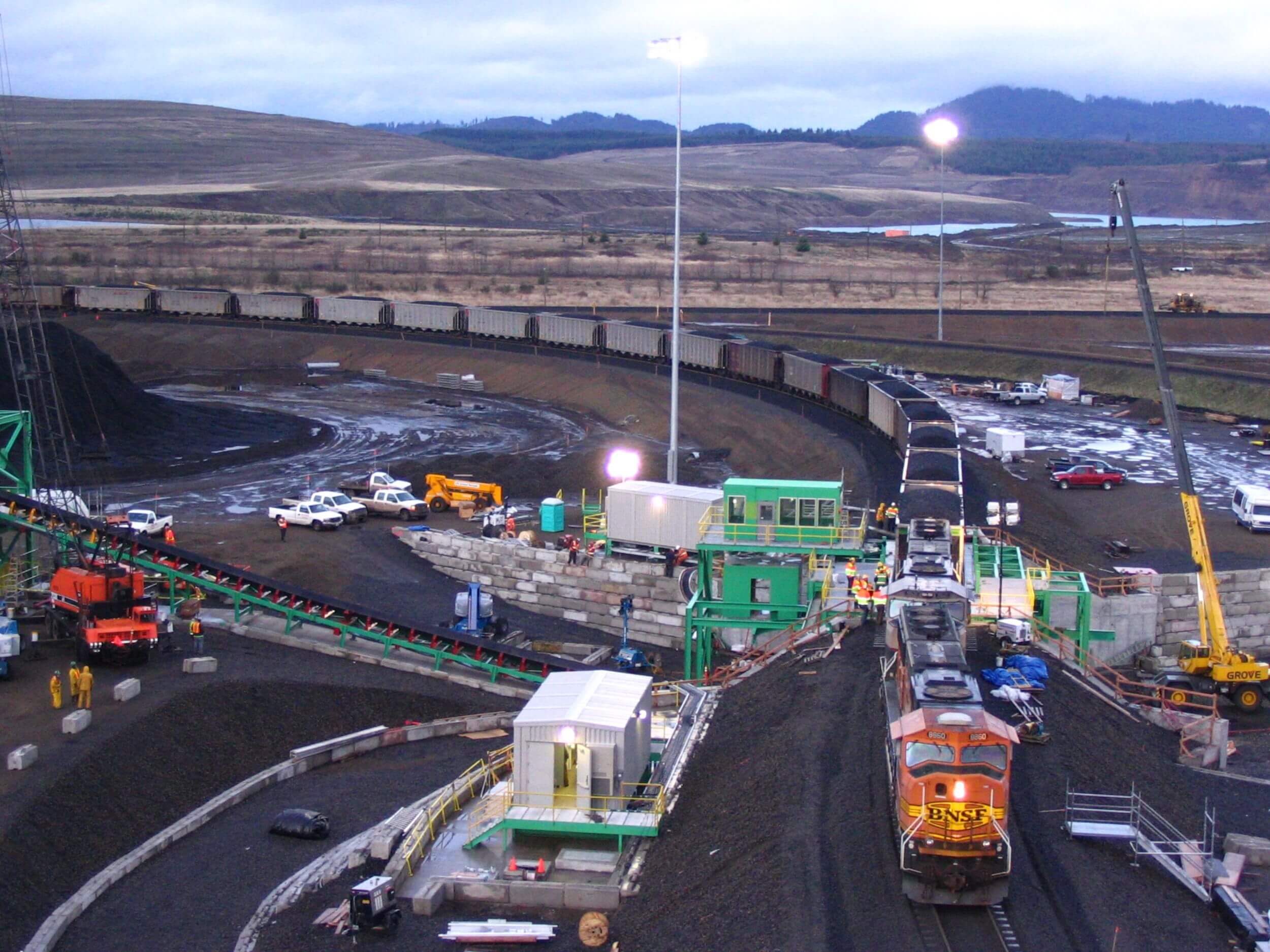
Coal rolls in to be burned at a power-generating station in Centralia, Washington. Deals negotiated years earlier ended generation by one of the two coal-burning units at the facility at the end of 2020, and the other unit is scheduled to be mothballed in 2025. Those cutbacks are helping Washington meet its climate-protection goals but many more reductions are needed. For example, this power plant also has units burning so-called “natural” gas, which has a lower but not insubstantial impact on the climate. (Credit: TransAlta Centralia Generation)
Allies in the business world warned “that we were going to get creamed,” said a former Climate Solutions colleague of Doglio’s, Ross Macfarlane.
“And I wasn’t sure they were wrong,” he said. “In fact, I was pretty sure they were right.”
The activists at Climate Solutions got an early jolt of confidence from opposition research, teaming up with the Sightline Institute and other coalition partners to dig into coal industry finances. Within a few months they knew that the economics of the proposals were shaky. For example, Sightline researcher Clark Williams-Derry obtained government documents from Australia showing that Ambre Energy, the force behind two coal-export proposals along the Columbia River, was deep in debt.
The coalition started cultivating relationships with stock analysts and others in the financial world, including reporters, Macfarlane recalled. They also began educating government leaders in the Northwest. Soon coal companies’ prospects did not look so rosy after all.
But more challenges lay ahead. The anti-coal campaign was still building momentum in 2013 when Eric de Place, then Sightline’s policy director, got a call from an environmental activist named Brett VandenHeuvel of Oregon-based Columbia Riverkeeper. He was worried about a plan to build an oil-export terminal at Vancouver, Washington, just across the Columbia River from Portland.
When VandenHeuvel didn’t get the response he wanted from de Place, he blurted, “Look, they’re talking about moving 360,000 barrels a day.”
To which de Place recalls laughing, and responding: “’Maybe you are misreading a number because nobody has ever moved that much oil by rail.’ I said, ‘Look, that’s the size of a pipeline. That’s not rail movement.’”
De Place agreed to look into the matter, and he quickly found that VandenHeuvel was right. The proposed $210 million Tesoro Savage rail-to-marine terminal really did contemplate unprecedented scale.
Oil trains more than a mile long would block emergency vehicles and other traffic on a daily basis in dozens of towns between Washington and Wyoming. And in a derailment or collision the oil could cause fearsome devastation.
Gas followed a few years later as a wave of proposals to export natural gas emerged, followed by several proposals to produce methanol from natural gas.
By the middle of last decade, a fossil fuel tsunami seemed to be pointed at Cascadia and its ports. But by then, environmentalists had also built a coalition far stronger than their partnerships with each other — a regional infrastructure of activism whose importance to the greens’ success is hard to overstate.
“That’s a real lesson learned: To be successful on major campaigns you have got to work outside traditional alliances,” Macfarlane said.
Environmentalists looked at who might be affected by each project or proposal and reached out, and often discovering natural allies who had already mobilized. Scouting far up the rail lines, they also found unlikely allies, from politicians in decidedly conservative towns along the rail routes to a concerned researcher for the Montana Wheat & Barley Committee. Lots of folks worried about traffic-jamming trains carrying volatile oil and gas.
They were far stronger together. Dedicated people at the grassroots level poured in their time and worked their community connections. Professionals at environmental nonprofits bolstered their case, providing expertise to, for example, challenge a company’s calculation about how much of a neighborhood would be decimated if a fossil gas train exploded.
“It’s all about grassroots resistance to the fossil fuel infrastructure,” said Climate Solutions’ Doglio. “Legislators really can’t ignore the massive outcry in our communities around trying to stop these fossil fuel projects.”
Indigenous peoples key to victory
First Nations and Native Americans were in the forefront and, in a few cases, provided pivotal legal firepower that won the day.
Take, for example, the proposal to build the Gateway Pacific Terminal, about 10 miles from the Canada-U.S. border, to ship coal to China — the project the Montana ranchers and tribal members traveled to Seattle to protest in 2012.
So many people wanted to be at that hearing that the U.S. Army Corps of Engineers had rescheduled the event, and moved it from a community college to the convention center. More than 2,300 showed up on that Dec. 14 day along with the Northern Cheyenne and their allies; more than 6,000 more attended other hearings for the project around the state.
In Seattle, opponents sang to the tune of “Deck the Halls”:
“We have lots of greener choices
Fa la la la la, la la la la
Stop the coal and
Raise our voices…”
The fatal blow for the Gateway Pacific coal terminal landed a few years later, when the Lummi Nation — whose reservation sits just south of the U.S.-Canada border — won a legal fight to convince the Corps to reject the proposed 3,000-foot wharf and rail trestle. The Lummi cited the 1855 treaty under which they gave most of their traditional territory to the United States and were guaranteed the right to forever fish at their “usual and accustomed grounds and stations.”

Pro-renewable energy protesters rally in Vancouver, British Columbia on Oct. 25, 2019. Massive rallies by people opposed to exporting fossil fuels along the west coast of North America have been critical to environmentalists’ surprisingly successful campaign to shut down coal, gas and oil exports to Asia. (Photo courtesy of the David Suzuki Foundation)
Like so many assurances to Indian tribes, that promise was later largely abandoned. Then a series of court rulings, starting in the 1970s and still controversial, held that Indians are entitled to half the seafood catch in Washington.
Taking aim at the coal-export terminal, the Lummi submitted fish catch reports dating back to the ‘70s showing that Lummi fishermen had long been landing crab, salmon, halibut, herring and cod in the waters around the proposed coal terminal. As a sovereign nation, the Lummi could expect the federal government to give their position serious consideration.
And they won. In 2016 the Army Corps declined the permit application.
In her decision, Michelle Walker, chief of the Army Corps’s regional regulatory branch, recognized not only the Lummi’s sovereign rights but also their distinct culture. “It is also important to note the Cherry Point area is known to the Lummi as Xwe’chi’eXen, which is part of a larger traditional cultural property,” she wrote. Fishing was not just a source of sustenance and wealth, wrote Walker, but also “important to the Lummi Schelangen (Way of Life).”
‘I am not an acceptable risk’
When government officials took seats behind long tables at one end of an Oregon high school gymnasium one rainy night, they faced about 100 locals sitting in folding chairs. Most wore red T-shirts that read:
“I am not an LNG ‘acceptable risk.’”
The locals’ show of force at Astoria’s Knappa High in 2005 was the first major public protest against the first of four terminals to import liquefied natural gas, proposed for sites along the Columbia River near the Pacific Ocean. Emotions ran high, elevated by the risk of catastrophic explosions associated with LNG tankers.
That 2005 hearing at Knappa High launched what became a decade-plus anti-LNG campaign by citizen activists.
It was love of the Columbia River that brought school librarian Cheryl Johnson into the fight. Johnson, who lives near the river in a small community called Brownsmead, spearheaded a key opposition group calling itself Columbia Pacific Common Sense.
Johnson’s organization came to coordinate myriad citizen opposition groups that popped up spontaneously along the river where the explosive fuel was to be transported, as well as across interior counties where a pipeline would plow through orchards, vineyards and pasture and leave behind the possibility of catastrophic explosions.
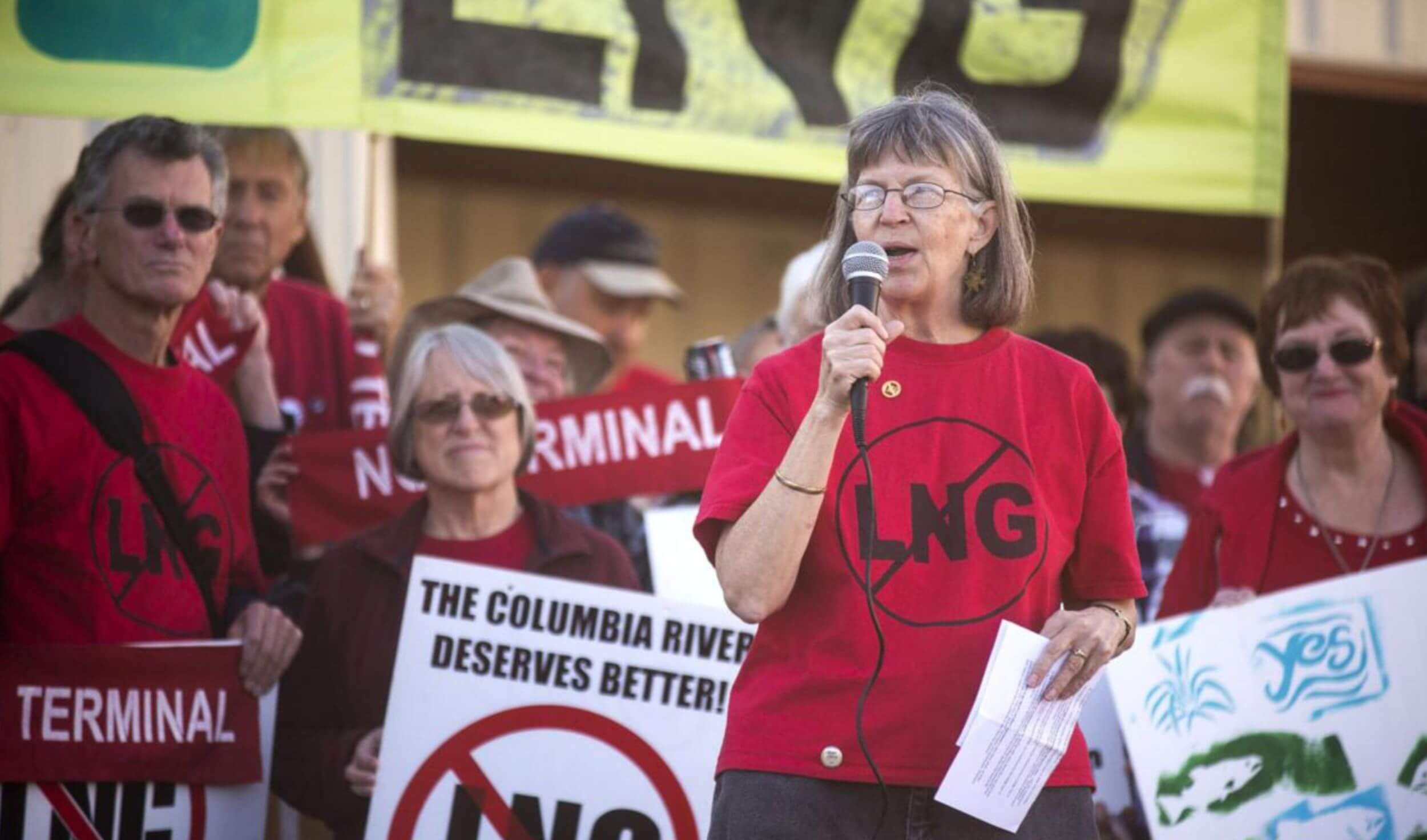
Cheryl Johnson, a school librarian turned anti-fossil fuel activist, speaks at a rally in 2015 in Astoria, Oregon, against liquified petroleum gas terminals on the Columbia River. Her environmental group helped many others that sprang up along the Columbia River to oppose proposals to export liquified natural gas. (Joshua Bessex/The Daily Astorian)
Like Johnson, most citizen activists had day jobs. They soon realized that they were girding for a fight over highly technical matters of science and law. They realized, she said, that they needed an environmental group with professional staff. With expertise.
Johnson and her collaborators found it in the Columbia Riverkeeper, a Pacific Northwest affiliate of the Waterkeeper Alliance founded by Robert F. Kennedy Jr.
“They said from the beginning: We have your back. We will help you,” Johnson said. “They were pivotal.”
The formula, according to Johnson: “We brought the local voice, and they brought the lawyers.” Scientists, too.
The citizens’ tactics: Workshops. Rallies. Handing out one-pagers at their monthly meetings and public hearings. Lots of time. Lots of preparation. Lots of nights reading and learning.
They used the internet extensively, along with events. A notice for a 2005 event offered: “Artist & activist Janet Essley will join us for a ‘Stencil Party.’ BYOT (Bring your own t-shirt, hat, posterboard etc.) and Essley will walk you through stenciling ‘No LNG’ artwork on items of your choice.”
They targeted the county commission, the city commission, the Coast Guard, the state Department of Environmental Quality, the Federal Energy Regulatory Commission — any agency that had decision-making authority over numerous government permits. Every month the far-flung local groups sent representatives on the two-hour drive to meet with Riverkeeper in Portland and plan strategy.
And when another show of force was required at a public meeting or event, word went out: This is a red-shirt meeting.
Crucially, when citizen activists failed to gain support from established green groups, they reached out beyond that movement. They involved fishermen who feared the damage to salmon habitat where the LNG plants would be built. They brought in tribes who depend on and venerate salmon. And they linked up with owners of vineyards and orchards whose long-nurtured lands would be riven by proposed pipelines.
Two of the proposals for LNG terminals quickly fell away. But two persisted for years as fracking projects conceived to import LNG were reborn as terminals to liquify cheap, abundant domestic gas for export to Asia.
The first was the Bradwood Landing project upstream from Astoria, proposed by NorthernStar Natural Gas. The Houston-based company that originally sought permits to import LNG, promising jobs and energy, converted it to export after fracking took off.
A key factor in defeating the proposal was a citizen referendum, crafted by the professionals at Columbia Riverkeeper and pushed heavily by local groups, that outlawed the company’s plan to build pipelines through publicly owned parks as project proponents planned. More than two-thirds of votes went for the opponents in a special election that spurred more than half of Clatsop County’s registered voters to weigh in.
About five years after that first public meeting at Knappa High, Johnson left her seat in a restaurant overlooking the Columbia one night to rescue a forgotten mobile phone from her car. Standing there in the parking lot, she saw 15 messages. Something was up. As she listened, she realized her side had prevailed.
Minutes later she was on the phone with a reporter asking for comment. Johnson was so choked up she couldn’t talk through her sobs of joy.
Six years later the other LNG proposal, slated for Warrenton, a former timber company town, finally died, too. There, the activists won by electing sympathetic voices to the county commission.
“What we learned is there is no silver bullet, there is no one thing,” Johnson said. “Big picture, it’s just throwing so many obstacles in their way that they finally decide it’s not worth it, and they pull out.”
Global impact
Cascadia’s activism has had global impact, contributing to a downgrading of fossil fuel industries’ moral standing and access to capital worldwide. In essence, activists here have been helping to “decarbonize” public opinion. But for all of their victories, it might be a stretch to say the fossil fuel industry is on the run. In fact, the industry continues to hold sway in important ways throughout Cascadia.
Trains carrying highly flammable Bakken crude oil still regularly pass through the Columbia River Gorge at the Washington-Oregon border. One derailed in June 2016 at a small Oregon town, sending up a massive fireball and closing a 23-mile stretch of Interstate 84 for half a day and evacuating a school and neighborhood. Fortunately, no one died. Another oil-bearing train derailed last month north of Bellingham, Washington.
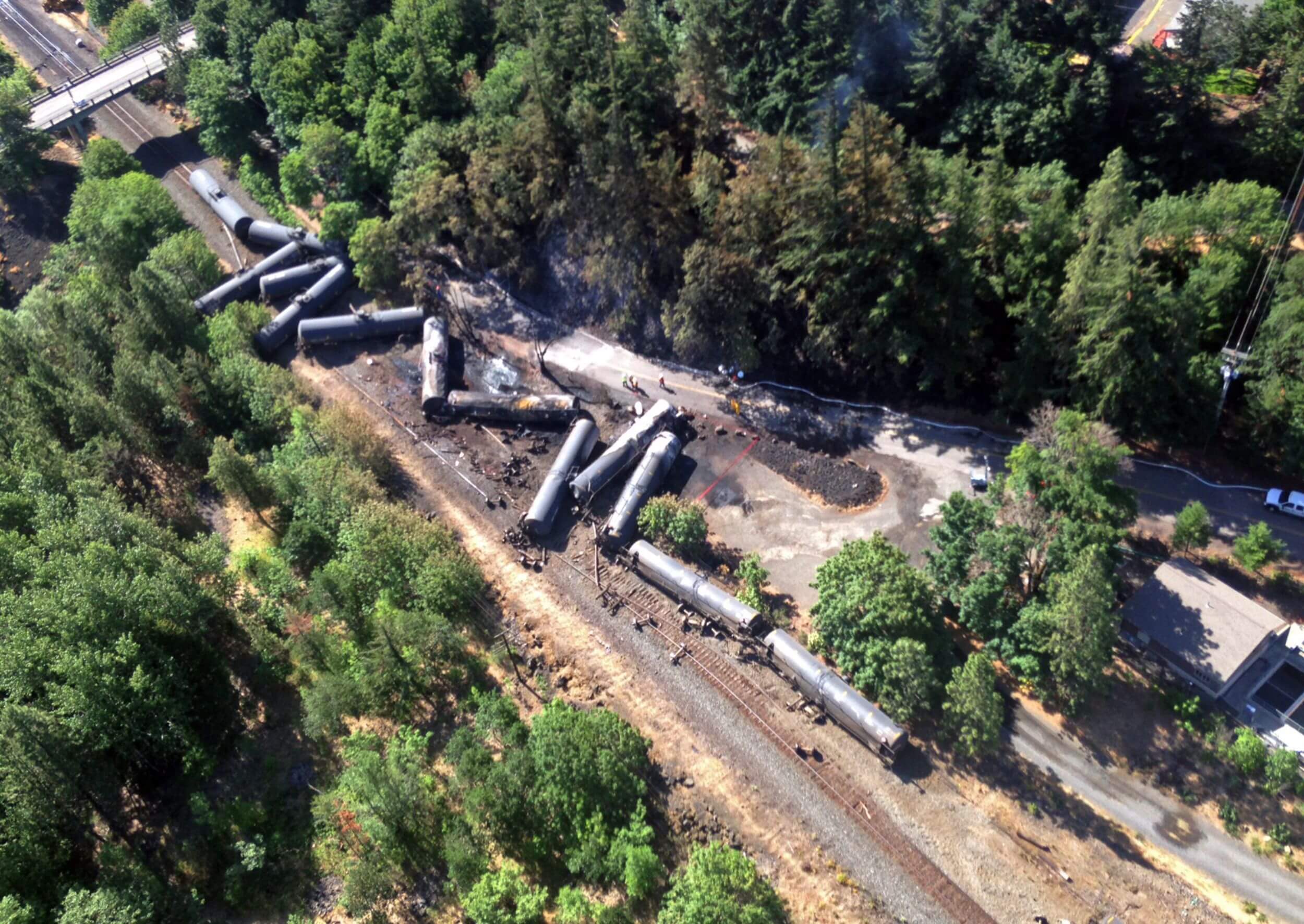
Oil tank cars lie scattered and burned after the train hauling North Dakota crude through the Columbia River Gorge derailed near Mosier, Oregon, in June 2016. Fears of such accidents and oil’s planet-warming effects have spurred grassroots actions that helped shut down fossil fuel export proposals over the last decade. (Washington State Department of Ecology via Associated Press)
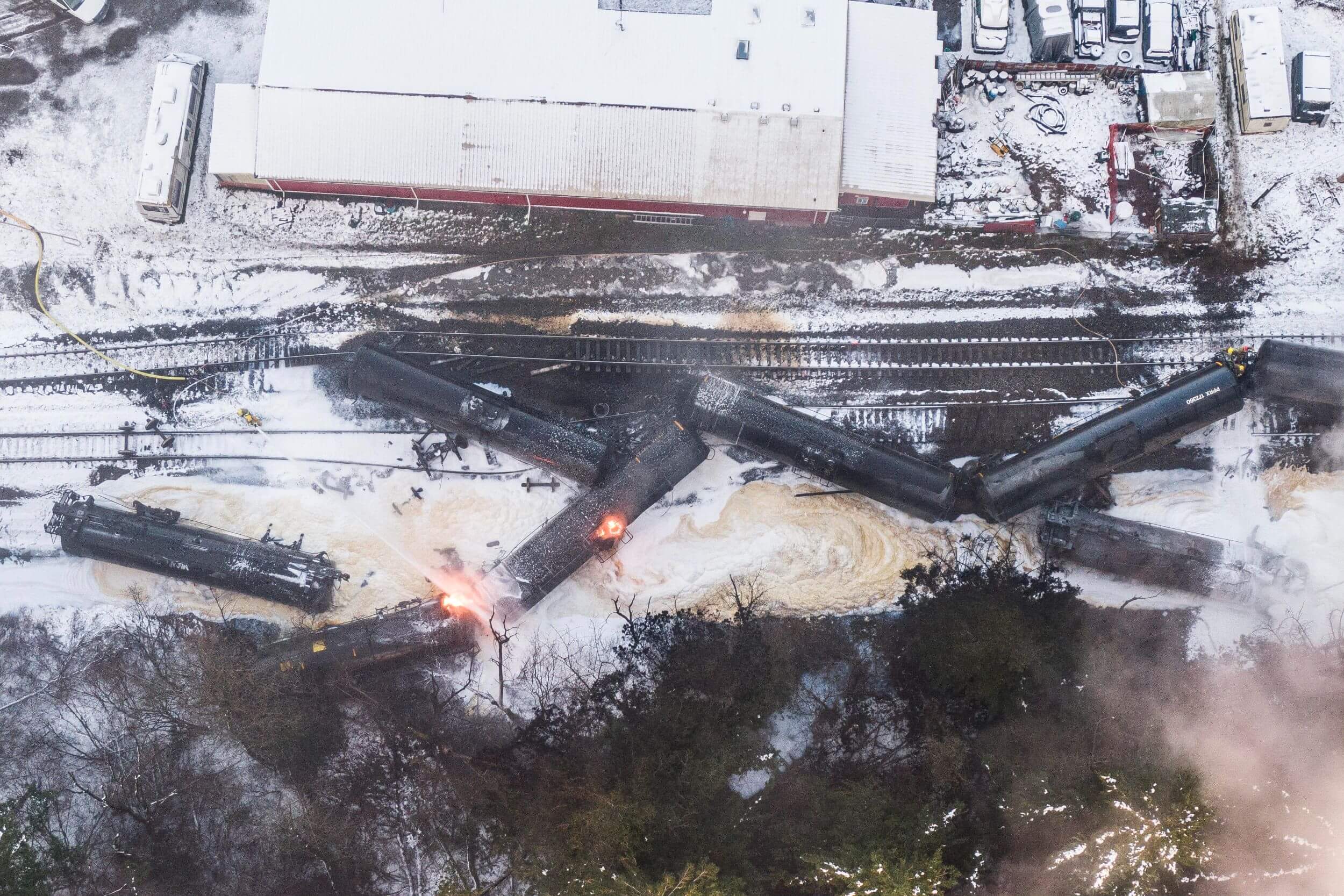
A train carrying crude oil burns while derailed on Dec. 22, 2020, in Custer, Washington, forcing evacuations of the area. Climate-protection activists who have fought off more than 20 proposals to export fossil fuels from the west coast have warned repeatedly about how an accident like this could be deadly in the urban areas these trains traverse. (Photo by David Ryder/Getty Images)
From the Columbia Gorge, these oil-bearing trains make a right, bisecting towns from Oregon to near the Canadian border. Most move through a century-old tunnel that runs beneath downtown Seattle. There, an explosion could easily result in massive evacuations and quite possibly more serious harm.
How did those get past the environmental groups? Simple: They didn’t see them coming. They had no clue when four out of five of Washington’s refineries applied for local building permits a decade ago to reconfigure rail lines that it would enable an oil-by-rail surge.
Only because of that phone call from Columbia Riverkeeper’s VandenHeuvel to Sightline’s de Place did any of that come to light. By then it was too late to stop those four refineries. They are now bringing in more than 100,000 barrels a day, on average, according to the Sightline Institute’s research.
They may get access to even more, thanks to the expansion of the TransMountain pipeline — one of several large fossil fuel export projects underway today in British Columbia.
Activists scared TransMountain’s longtime owner, Kinder Morgan, off the expansion project only to see it rescued by being purchased by Canada’s federal government. It would nearly triple the capacity of a pipeline that delivers diluted [su_tooltip position=”north” shadow=”yes” size=”2″ title=”Bitumen” content=”A tar-like heavy petroleum mined in Western Canada. Bitumen requires considerable energy to extract, ship and refine and thus has a higher carbon footprint than many other petroleum-based fuels.”][su_highlight background=”#ffeb1c”]bitumen[/su_highlight][/su_tooltip] (the heaviest form of crude oil) from Canada’s tar sands in Alberta to just outside Vancouver, BC. It was justified to ship petroleum to China and other Asian countries by tanker, but also sends diluted bitumen to Washington refineries via barge and pipeline.
While TMX moved forward against objections from British Columbia, the government actively courted two other megaprojects under construction: the LNG Canada gas export terminal in Kitimat and the associated Coastal GasLink gas pipeline bringing fracked gas to Kitimat from Northeast British Columbia.
A similar development called Jordan Cove remains a possibility in southern Oregon. Just ask Clarence Adams, who lives near Eugene. Adams fought for years before he saw the U.S. Federal Energy Regulatory Commission uncharacteristically reject the proposal to export liquefied natural gas through nearby Coos Bay in 2016.
It seemed like victory. But it was short-lived. Opponents ran a ballot measure the next year to permanently kill the proposal, dubbed Jordan Cove and backed by Calgary-based Veresen Inc. Adams’ side got killed. The vote was 76% to 24%. Veresen’s forces spent about $32 for each vote in its share of the 17,249 ballots cast, flooding the airwaves and buying newspaper ads. Proponents managed to spend just about one-tenth of that, or $3.20 for each of the approximately 4,100 votes they garnered.
Then President Trump began winning appointments to the five-member Federal Energy Regulatory Commission and its balance tilted to favor the Jordan Cove proposal.
Adams, who retired from a job helping the Umpqua National Forest process timber harvests, is pretty sure this version of the plan will fail as previous ones have. For one thing, Pembina Pipeline Corp., a Canadian firm that subsequently took over the project, has been unable to secure several permits from the state. Low prices for natural gas globally could also hinder the proposal.
Or not. “My worst fear is some American company will come up and buy it out and we’ll have a fourth iteration and try to push it through for American gas,” Adams said. “A lot hinges on the global gas market.”
Back in Seattle, Sightline’s de Place said last week that activists trying to maintain the thin green line continue to monitor Jordan Cove and several other fossil-fuel export proposals, the largest being British Columbia’s TransMountain Pipeline expansion.
But looking back through the years, he said Cascadian activists’ efforts “have been a smash hit.”
“I thought when we started out… that we would not win any of the fights, and as it turned out we came close to running the tables,” de Place said. “We established that fossil fuels do not have a safe harbor in the Northwest.”
Still, his title at the tSightline think tank/activist group reflects the reality that this is an ongoing fight. He’s now called the Thin Green Line Director.
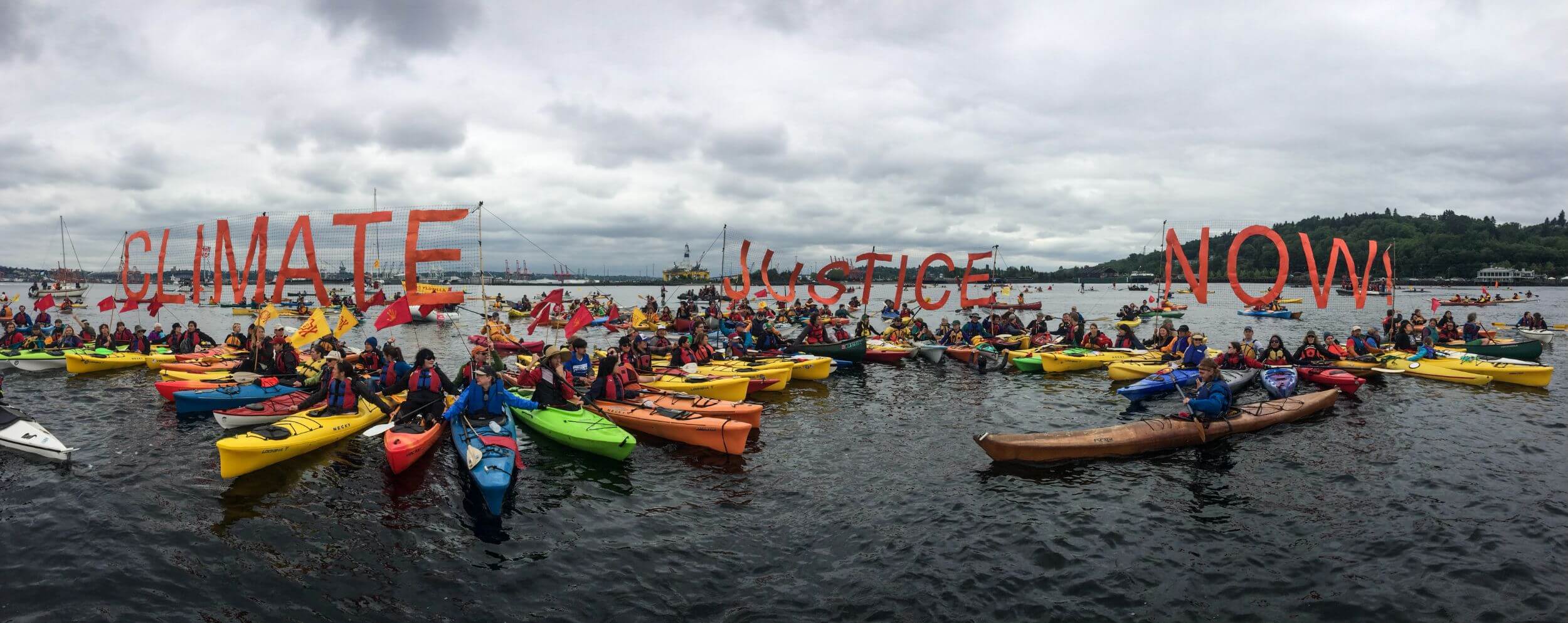
Hundreds of “kayaktivists” amassed in Seattle’s Elliott Bay to oppose plans to transport this Shell Oil drilling rig bound for the Arctic. Three months later, Shell cancelled the plans. Mobilization of thousands of people across Cascadia led to the failure of most proposals to export fossil fuels from the west coast over the last decade. (Photo by Joshua Trujillo)
Next month in Getting to Zero:
After a decade of climate policy drift in Cascadia, recent years have produced signs of life in the region’s effort to cut emissions. There is a newly emerging roadmap to follow thanks to modeling from Washington State, and clean energy is now the cheapest available. Can Cascadia —Washington included — finally find the political will?
“Extracting dirty energy is an affront to our way of life. Period.” As she spoke to nearly 100 activists gathered at Seattle’s Green Lake to protest the expansion of the TransMountain petroleum pipeline, Ellany Kayce wore a downsloping hat made of cedar in the tradition of her Tlingit Indian tribe — meaning she carefully selected a tree, asked its permission and gave it thanks before taking a 12-inch slice out of the side and then painstakingly molding the wood. Overall the process takes 15 hours.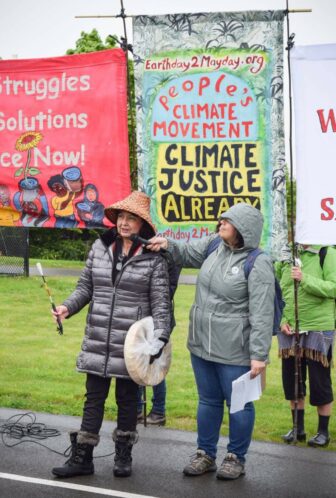
Kayce was also clad in a ceremonial black and red Tlingit shawl embedded with rare mother-of-pearl buttons in the shape of a raven — her Tlingit clan.
It was a sunny summer Friday evening in 2017 following Seattle’s rainiest winter and spring on record. And yet scores of Seattleites, many in their 20s and 30s, followed Kayce — a Seattle resident whose tribe lives in British Columbia and Southeast Alaska — for nearly 3 miles through the mostly-white northern end of Seattle.
They’re worried that tankers leaving Canada will cause spills in the Salish Sea, the straits between Vancouver Island and the mainland, and in Puget Sound, Washington’s famed inland sea.
As Kayce explained in an interview after the protest: “We want to ensure our treaty rights are honored and that we’re the stewards of Mother Earth, which means we want to protect the water and the land and our health and well-being for the next seven generations. That’s part of our role on Earth.”
Learn more about the fight against the TransMountain Pipeline expansion — a losing fight, so far — in next month’s installment of Getting to Zero: Decarbonizing Cascadia.

